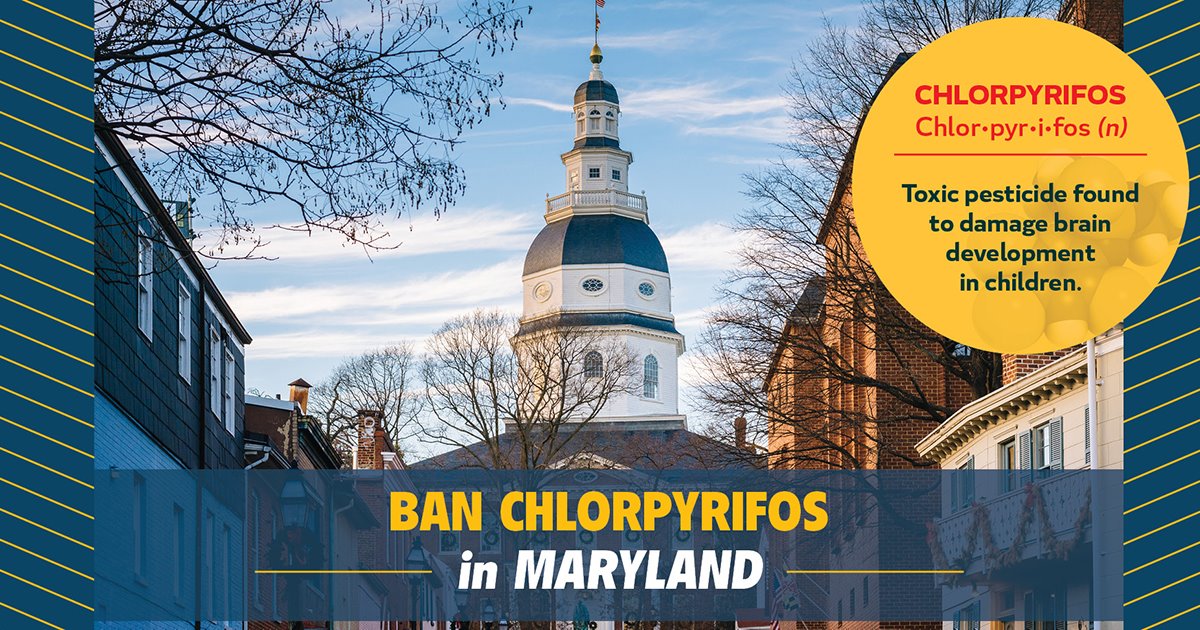24
Mar
Maryland Legislature Passes Limited Ban on Chlorpyrifos Insecticide

(Beyond Pesticides, March 24, 2020) Last week, Maryland became the latest state to prohibit use of the brain-damaging insecticide chlorpyrifos, after a measure cleared both the state Senate and House. Although the legislation implements a limited ban that sunsets after four years, advocates consider this action a step in the right direction that will protect the health and safety of Maryland residents. “Even amidst our current public health crisis, the Maryland legislature acted to protect all Marylanders’ health for years to come by banning this toxic pesticide, and we are so grateful,” said Ruth Berlin, Executive Director of the Maryland Pesticide Education Network to WBOC.
Chlorpyrifos is an organophosphate insecticide known to inhibit the proper nerve functioning by affecting the enzyme acetylcholine esterase. The impacts of this pesticide are particularly concerning for young children, as research finds that children exposed to high levels of chlorpyrifos had mental development delays, attention problems, attention-deficit/hyperactivity disorder problems, and pervasive developmental disorder problems at three years of age.
While Maryland is the fourth state to restrict the use of chlorpyrifos, it is the second to implement these restrictions through legislation. In California, the state Department of Pesticide Regulation is implementing a phase out of most uses through a rulemaking process. The state of New York was poised to follow Hawaii, the first state to ban the chemical through legislation, but Governor Andrew Cuomo (D) issued veto and instead directed a phaseout through rulemaking.
Maryland’s law bans chlorpyrifos for four years before a sunset clause comes into effect, meaning that the legislative ban will end after this period. However, at the same time as this legislation worked its way through the legislature, the Maryland Department of Agriculture (MDA) announced a rulemaking process to prohibit use of the chemical. Advocates are hopeful that the administrative restrictions will be completed by the time the legislative ban sunsets, but generally saw this approach as an attempt to stymie lawmaker efforts. “MDA is simply not equipped financially or with expertise to develop and defend a regulation banning chlorpyrifos,” Smart on Pesticides, the coalition group pushing for pesticide restrictions in the state, told Maryland Matters.
The lawmaker ban also provides limited exemptions for chlorpyrifos use on the trunks of fruit trees and to snap beans grown in the state. It establishes a working group funded by the state that includes state agencies, industry proponents, nonprofit advocacy groups, and health professionals, with the aim of assisting growers in transitioning to alternatives. The bill will now head to Governor Larry Hogan for final signature.
As more and more states, such as Connecticut, Oregon, and New Jersey consider chlorpyrifos bans, the major manufacturer, Corteva (formerly DowDupont), announced it would stop producing the chemical by the end of the year. Despite this major disruption to the market, the U.S. Environmental Protection Agency (EPA) is refusing to cancel chloryprifos’ federal registration. This approach at the national level stands in stark contrast to a move by the European Union, which decided not to renew approval following a comprehensive analysis from the European Food Safety Authority.
The impacts of continued use of chlorpyrifos and other pesticides in the organophosphate class are stark. A study published earlier this year found that these insecticides result in 26 million lost IQ points and over 110,000 cases of intellectual disability each year. If the human factor somehow doesn’t sway concern over these highly toxic chemicals, note that this totals approximately $735 billion in economic costs annually to the economy.
Last month, Corteva announced it will stop producing chlorpyrifos by the end of this year as a result of declining sales. Despite the move being in the interest of public health, the company is earning little praise from health advocates for what amounts to simply a shrewd financial decision. As news articles on the announcement have noted, Corteva will continue to support EPA registration of chlorpyrifos, which allows generic manufacturers to continue to sell this brain-damaging chemical.
Organic agriculture proves that hazardous pesticides, like chlorpyrifos, are unnecessary to grow crops that meet the demand for residents in the U.S. and around the world. Although organic agriculture is growing globally, there is still significant progress that needs to be made to expand cropland and incentivize farmers to transition away from chemical-intensive practices. The failure of EPA to adequately restrict chlorpyrifos exemplifies a dramatically broken regulatory system with hundreds of hazardous pesticides permitted for use that pose a range of public health and environmental threats. To reject these hazardous pesticides, you can help push for long needed changes– join Beyond Pesticides in telling Congress to help organic farmers hurt by the pandemic today.
All unattributed positions and opinions in this piece are those of Beyond Pesticides.
Source: WBOC










